Key takeaways
- Remote sessions enhance collaboration by breaking down geographical barriers and fostering deep communication and trust among artists.
- Sessionwire’s features, such as real-time audio streaming and DAW screen sharing, significantly improve the collaborative experience, reducing latency and technical frustrations.
- Success in remote sessions relies on effective setup, including testing equipment, minimizing distractions, and clear communication of goals and expectations.
- Building rapport through small rituals and maintaining a sense of presence can enhance creativity and engagement during virtual collaborations.

Understanding Remote Sessions in Music Projects
Remote sessions in music projects have transformed how artists and producers collaborate. I remember before this shift, coordinating schedules and traveling to studios felt like a constant hurdle. Now, the ability to connect virtually breaks down those barriers, making creativity flow more easily across distances.
Have you ever wondered how the energy of a studio session translates when you’re miles apart? From my experience, there’s a different kind of focus and patience involved, but it doesn’t diminish the magic. Remote sessions demand a new level of communication and trust, which often deepens the creative bond.
Understanding these dynamics is key to embracing remote music work. It’s not just about technology; it’s about adapting our workflow and mindset. When you grasp this, tools like Sessionwire become more than software—they become vital partners in a truly collaborative journey.
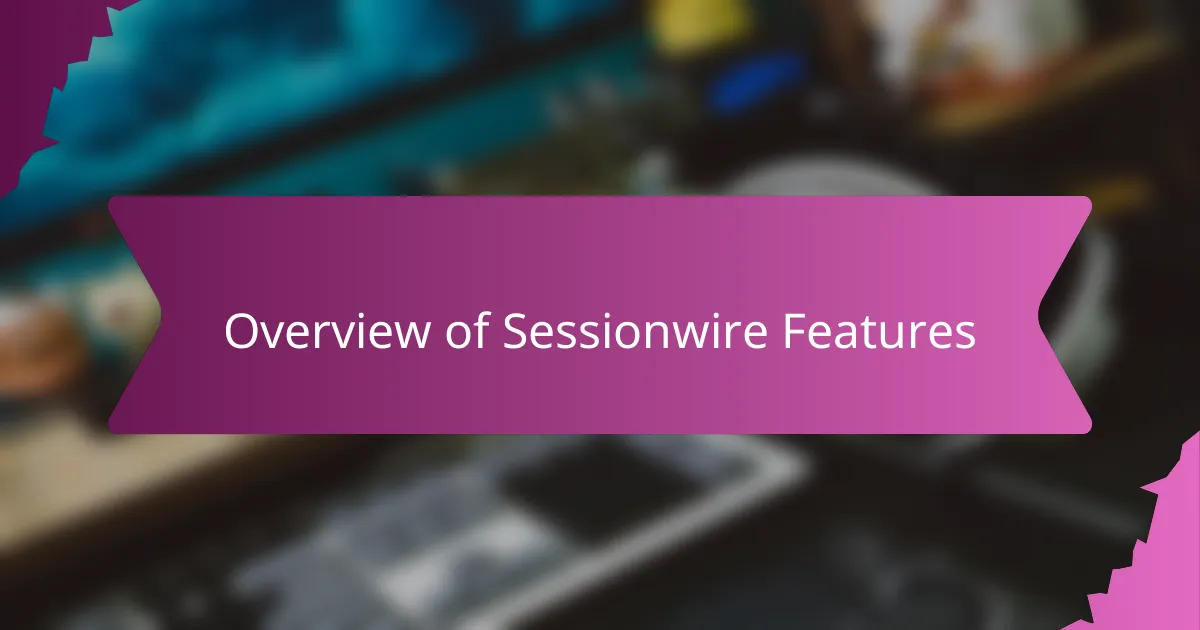
Overview of Sessionwire Features
Sessionwire’s features struck me as thoughtfully designed for genuine collaboration. I’ve always appreciated how its high-quality audio streaming lets you hear every subtle nuance in real-time, which, to me, is crucial when you’re trying to capture that perfect vibe remotely. Have you ever struggled with lag or poor sound that kills the creative flow? Sessionwire practically eliminates that frustration.
One feature I find particularly useful is the ability to share your DAW (Digital Audio Workstation) screen seamlessly. It’s like being in the same room, watching your partner’s moves in the session, which builds a sense of presence I didn’t expect from a remote setup. This visual connection adds an emotional layer to communication that chat or video alone often misses.
Another thing that surprised me was how intuitive Sessionwire’s session management is. Scheduling, inviting collaborators, and syncing tracks happen smoothly without the usual technical headaches. From my experience, this ease of use means you spend less time wrestling with software glitches and more time making music—exactly what every project needs.
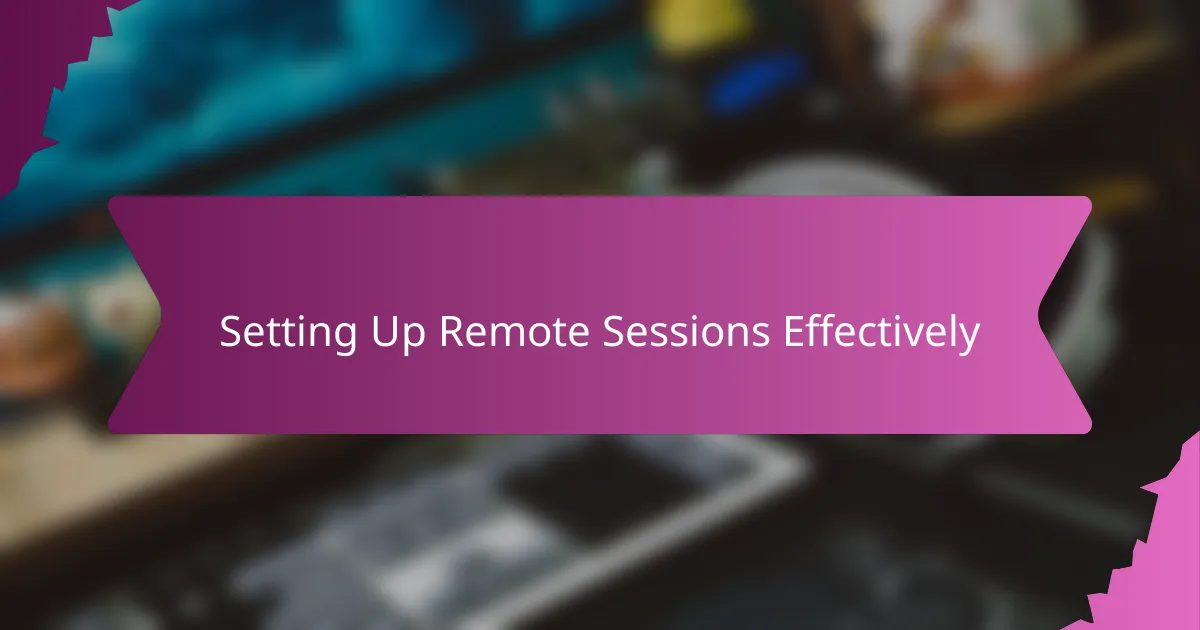
Setting Up Remote Sessions Effectively
Setting up remote sessions effectively starts with ensuring everyone’s tech is up to the task. I’ve learned the hard way that even the best connection can falter if someone’s audio interface or internet speed isn’t reliable. Taking a few moments to test equipment beforehand saves countless headaches later and keeps the creative momentum alive.
Another detail I focus on is creating a comfortable environment for all participants. Have you noticed how distractions, even small ones, can break your concentration during a remote session? I try to encourage everyone to find a quiet space and minimize background noise—it really makes a difference in how engaged and present everyone feels.
Then there’s the importance of clear communication before and during the session. Setting expectations about goals, timelines, and feedback helps me avoid surprises and makes the collaboration feel more intentional. When everyone knows the plan, remote sessions flow much more smoothly, and the creative energy stays focused.
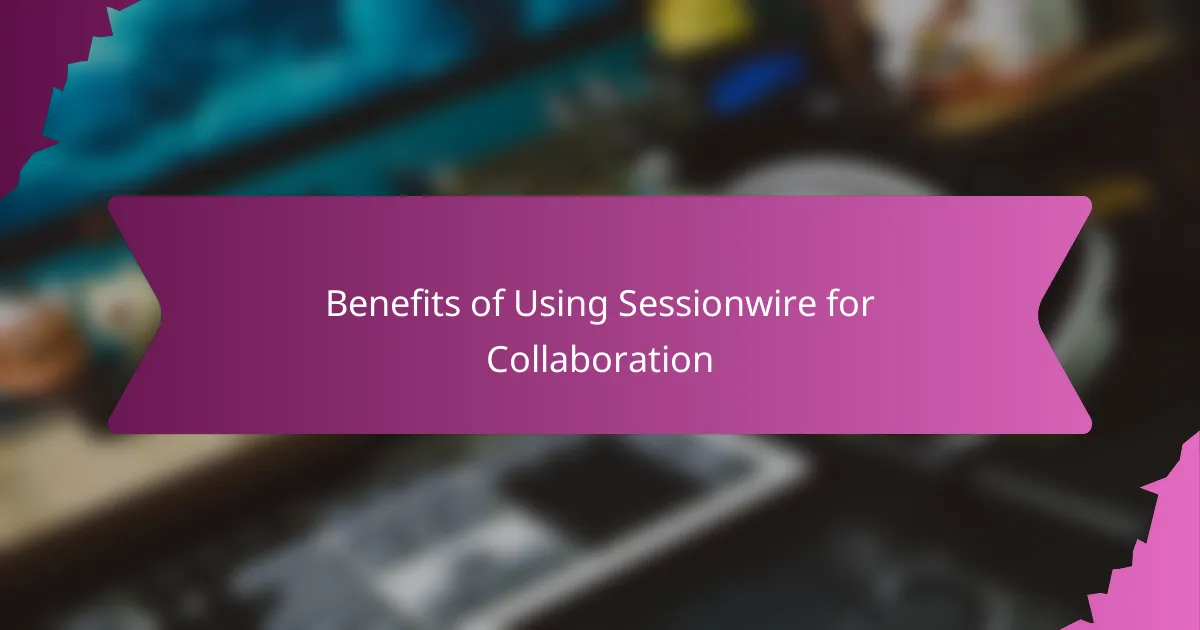
Benefits of Using Sessionwire for Collaboration
One of the biggest benefits I’ve found using Sessionwire is how it bridges the gap between distance and creative connection. Have you ever felt that awkward pause or miscommunication in a remote session? With Sessionwire’s real-time audio and screen sharing, those moments shrink, making me feel like we’re actually side by side, vibing off each other’s energy.
Another advantage that stands out is the streamlined workflow during collaboration. I remember times when juggling multiple platforms left me frustrated and disconnected. Sessionwire’s integrated session management means invitations, syncing tracks, and feedback all happen within one space, which lets me stay fully immersed in the music instead of technical distractions.
Lastly, the emotional confidence I gain from using Sessionwire can’t be overstated. Knowing that everyone hears exactly what I’m playing, with minimal latency, gives me the freedom to express ideas more openly. Has remote work ever felt cold or mechanical to you? For me, Sessionwire injects warmth and immediacy that nurtures trust and fuels creativity.
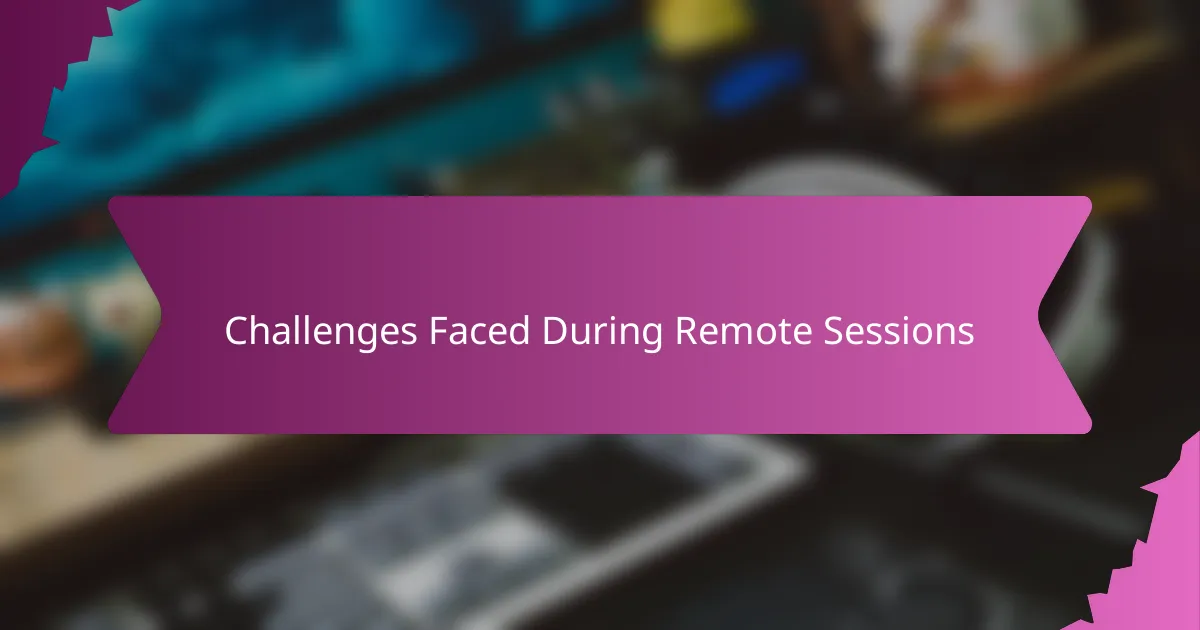
Challenges Faced During Remote Sessions
Sometimes, despite all the advanced features, I’ve found that latency still sneaks in during remote sessions. Have you ever felt that tiny delay throw off your timing? It’s subtle, but in music, even milliseconds can disrupt the groove, making synchronous playing a real challenge.
Another hurdle I often face is the lack of spontaneous jam moments that happen so naturally in a studio. When you’re not physically in the same room, those improvised, electric interactions can feel muted or forced. I’ve had sessions where the vibe just didn’t click, and it reminded me how much energy space and presence contribute to creativity.
Then there’s the occasional technical glitch—unexpected dropouts or audio quality dips—that can break the flow right when inspiration strikes. I remember a session where a collaborator’s connection kept cutting out, and the frustration was palpable. At times like those, patience and quick troubleshooting become as important as the music itself.
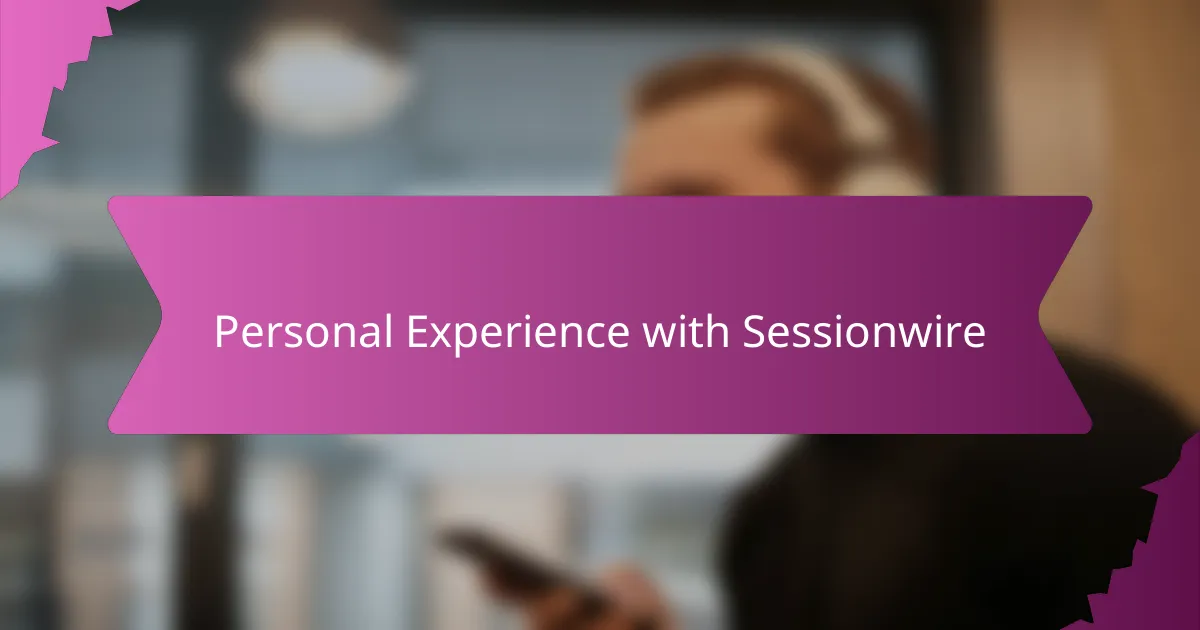
Personal Experience with Sessionwire
Using Sessionwire for remote sessions has genuinely reshaped how I connect with collaborators. I remember the first time I heard a perfectly synchronized take despite us being miles apart—I felt a mix of relief and excitement, as if the distance had momentarily vanished. It’s moments like that which make me appreciate how the platform manages to capture the essence of live collaboration.
Of course, not every session feels flawless. There was one time when a brief glitch threw off the timing, and I found myself wondering, “Can this really replace being in the same room?” But then, as we regrouped and communicated through Sessionwire’s tools, the process became surprisingly smooth again. Those little hurdles remind me that patience and adaptability are key when working remotely.
What I value most, though, is how Sessionwire’s screen sharing invites me into my collaborator’s creative space. Watching their DAW moves in real-time feels like peeking over their shoulder and sparks ideas in a way that just talking over video can’t. That sense of presence—however virtual—is what keeps me coming back to remote sessions with renewed enthusiasm.
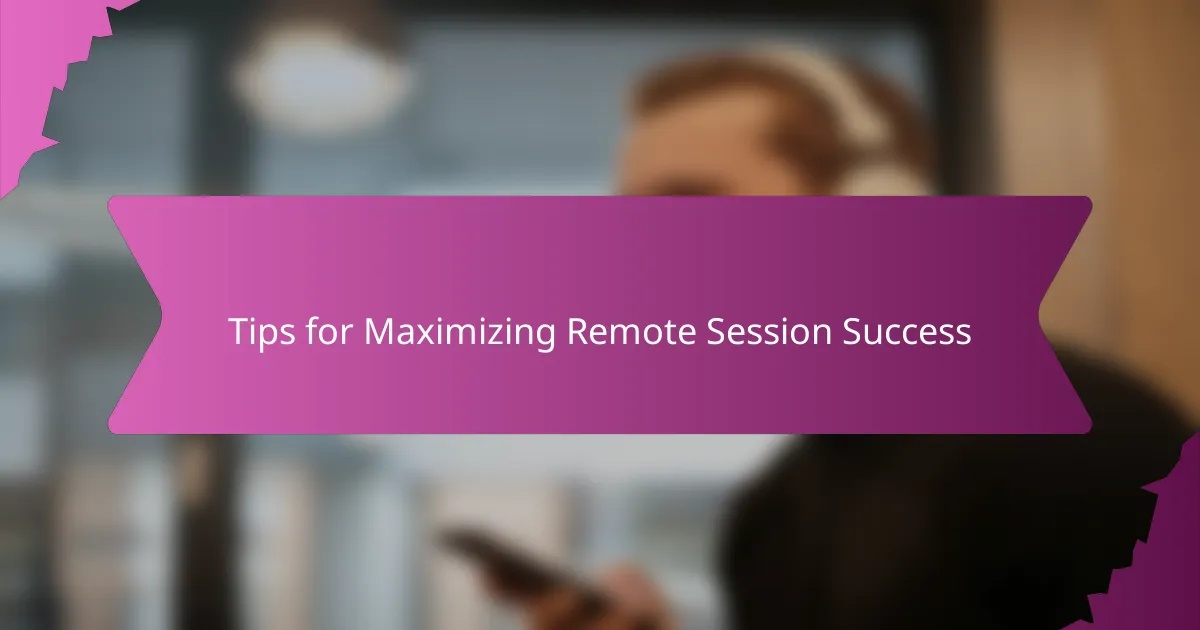
Tips for Maximizing Remote Session Success
One tip I’ve found invaluable is to prioritize clear and honest communication before the session even begins. Have you ever jumped into a remote jam only to realize everyone’s expectations were completely different? Setting goals and checkpoints ahead of time saved me from headaches and kept the session flowing naturally.
Another thing I always emphasize is testing your gear thoroughly before diving in. I remember a frustrating session where a collaborator’s microphone kept cutting out, and it threw off our entire vibe. Taking just a few extra minutes to check connections and audio quality made a huge difference in maintaining focus and energy.
Lastly, I try to create little rituals that mimic in-person sessions—like quick greetings or informal chats—to build rapport. Remote work can sometimes feel cold and mechanical, right? But I’ve noticed that these small moments of human connection spark creativity and keep everyone engaged throughout the process.